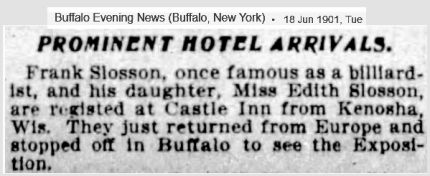|
Edith M. Brown
Edith was the only child of Charles C. Brown jr
(1852–1932 and Minnie Doan Brown (1855–1923). In
1903 she worked as a cashier at Kenosha's oldest
bank, the First National Bank in Kenosha on 6th
Avenue, where her father also worked.
Charles had come to Wisconsin with his parents as a
small boy when Kenosha was named Southport. The
family soon settled in Milwaukee, but Charles
returned to Kenosha as a young man in 1868 and went
into the mercantile business. One of his partners
was Seth Doan. In 1877 Charles married Seth's
daughter, Minnie Doan, in the first marriage
ceremony performed at Kenosha's new Episcopal
church.
In the years after the fire
Three years after the fire, in 1906, Edith Brown
married Walter J. Cavanaugh (1879–1919), son of a
prominent Kenosha attorney and a former University
of Chicago football celebrity. After his early death
in an auto accident, she lived with her parents and,
after the death of her mother, with her aged father.
By 1909 Charles C. Brown had risen to become
president of the First National Bank. He went on to
also head the Northwestern Loan & Trust Co. and the
Brown National Bank. Charles was active in his
community, helping to establish a hospital and a
library. It was a legacy his daughter would emulate.
Mother of Pottawatomie Hills
Edith Brown Cavenaugh committed herself to the Girl
Scout program in Kenosha after her husband's death.
Over a period of thirty years, she served in various
local and national offices of the organization. In
May 1929, she was the girl scout commissioner who
took receipt of a gift of 80 acres of land and a
cash donation with which to start a girl scout camp
on Lake Pleasant north of Elkhorn, Wisconsin,
today's
Pottawatomie Hills.
The donation came from Jessie Halleck Nash, wife of
Charles W. Nash, president of Nash Motors, best known for the
Rambler.
(The 4th largest U.S. auto manufacturer in 1929,
Nash had been founded in Kenosha.) Edith's
involvement in the project earned her the nickname
Mother of Pottawatomie Hills.
Sadly, Edith died after a lengthy illness, never
remarrying or having children. She was not isolated, however. In addition to Girl Scouts,
she was involved in the St. Matthew's church woman's
auxiliary.
|

|
Frank Slosson
Frank was secretary at the
Bain Wagon Company
in Kenosha.▼1 He was the son of Martin Slosson
(1803–1888) and Sabra Avery Slosson (1802–1894). He
had lost his wife, Elizabeth Lyman (1856–1891), in
1891. Nothing was reported to suggest whether Edith
Brown and Frank's relationship was romantic. If it
was, he had a daughter the same age as Edith, so
tongues may have been wagging in Kenosha, then a
community of just over 10,000 where such goings-on
would have been noted. I came across the snippet
below at the bottom of a newspaper page. Note that
Frank's daughter's name was Agnes Narramore Slosson,
not Edith. Given that the Frank Slosson of billiards
fame was actually named George Franklin Slosson and
was still alive in 1916, whereas the Frank Slosson
of Kenosha, who survived the Iroquois Theater fire,
died in 1911, the entire snippet might have been
based on supposition. Still, it is curious that the
woman named in the hotel registry as the daughter of
Frank of Kenosha was an Edith instead of an Agnes.

According to a passport application, Frank Slosson
was 5' 6 with a dark complexion, medium build, gray
eyes, a long nose, and a mustache. As a young man,
he had graduated from Lenox Academy in Lenox,
Massachusetts, then became a telegrapher. When the
Civil War started, he enlisted at age sixteen in Co.
B in the 49th Massachusetts infantry. He was
detached from the company and became part of the
telegraph corps under
General Thomas Thompson Eckert. Slosson moved to
Wisconsin in 1870.
In the years after the fire
Frank Slosson went to Tokyo in April 1910 for a
six-month stay. Back in the states in February 1911,
he died of complications following surgery for a
perforated stomach. His brother, Judge Russell
Slosson in Kenosha, followed four months later.
Frank's daughter Agnes inherited $100,000 worth of
stock in Bain Wagon Company. In accompanying
stories, it was reported he had been a general
manager at Chicago-Kenosha Hosiery. He was replaced
by Henry S. Cooper of the Cooper Underwear company
in Kenosha — the same company that lost two at the
Iroquois.
|
